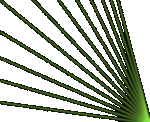|
Methods of hologram
chemical treatment
We
start with the most prevalent method of hologram
recording on PFG-03m photoplates. Index "m"
means a modernized photoplate of PFG-03 type, which
sensitivity is increased 1.5-2 times. Technical
characteristics of the "Slavich" photoplates
are given in the "Files" section.
Development
Holograms
on PFG-03m photoplates are better developed in GP-3
developer, though quite good results could be achieved
with GP-2 developer. According to our investigations,
the brightness of holograms in the latter developer
is less than in GP-3.
Here
are the compositions of both developers:
GP-2
Methylphenidone 0.2 g
Hydroquinone 5 g
Sodium sulfite (Na2SO3)
100 g
Potassium hydroxide (KOH) 5 g
Ammonium thiocyanate (NH4CNS)
12 g
Water up to 1 liter |
GP-3
Methylphenidone 0.2 g
Hydroquinone 5 g
Sodium sulfite (Na2SO3)
100 g
Potassium hydroxide (KOH) 25 g
Ammonium thiocyanate (NH4CNS)
45 g
Water up to 1 liter |
Methylphenidone
may be dissolved in a small quantity of hot water
or alkaline solution, and then poured into the general
solution.
Our
research has proved that GP-3 developer works better
when the quantity of thiocianate is reduced to 30
g.
The
working solution for both developers is formed by
dissolving 15 ml of the concentrated solution in
400 ml of water. It is advisable to allow the working
solution for 10-15 minutes prior to the development,
having thoroughly stirred it with a glass stick.
Development
time for GP-2 is 15 minutes, for GP-3– 8 minutes.
Development temperature is 17 C0.
Fixation
Fixation of PFG–03
runs very quickly, since the size of the bromide silver crystals is very small (tens of
nano-meters). Some specialists do not advise to fix holograms at all. It is useful when a
minimum emulsion layer shrinkage is required, for example, for manufacturing of reflecting
master-holograms.
We, however, fix
holograms in an ordinary neutral fixer with the following composition:
Sodium thiosulfate (Na2S2O3*5H2O)
150 g
Water up to 1 liter
Fixation time is 2-3 min with continuous rocking. |
Optimisation
of the drying of the holograms
Careful drying after
photochemical processing plays an important role in the final visual quality of the
hologram. For Russian photoplates we have used drying by ethanol. The plate is
consecutively dipped in baths containing 50%, 80% and 100% ethanol for 1-2 mins and
constantly agitated. However this process by itself does not give stable results.
The analysis of the
drying process shows that only complete and homogeneous removal of the water from the
surface of the emulsion layer guarantees a high quality of the final hologram. The
presence of water inside of the emulsion layer does not influence the uniformity of the
hologram. However a thin layer of surface water is separated with large effort from the
surface and frequently remains even after processing in 100% ethanol. Consequently
coloured stripes and spots appear on the hologram. To remove the surface water it is
necessary to change the method of drying as follows [1]:
In all the ethanol
baths the holograms are lifted from time to time  as shown in figure and are kept in this
position for 10-20 sec. Between raisings of the hologram it is necessary to rock one time
the bath to mix the solution of ethanol. When the water flows down from the surface of the
hologram near to the part immersed in the solution of ethanol some knots becomes visible.
When all the water has flowed down this knots disappears. This serves as a sign of the end
of dehydration in the given ethanol bath and the necessity to proceed to the next ethanol
bath, where the procedure repeats. In last 100% ethanol bath the surface of water vanishes
completely. This drying method can be used for any holographic photoplate or film. as shown in figure and are kept in this
position for 10-20 sec. Between raisings of the hologram it is necessary to rock one time
the bath to mix the solution of ethanol. When the water flows down from the surface of the
hologram near to the part immersed in the solution of ethanol some knots becomes visible.
When all the water has flowed down this knots disappears. This serves as a sign of the end
of dehydration in the given ethanol bath and the necessity to proceed to the next ethanol
bath, where the procedure repeats. In last 100% ethanol bath the surface of water vanishes
completely. This drying method can be used for any holographic photoplate or film.
The processing of
holograms in spirit baths occurs in a thin surface layer of the dry gelatin. It is as
though a "crust" prevents the exit of water. The water begins to leave the
emulsion layer only after the hologram is taken out of the last ethanol bath and the
spirit has evaporated from its surface. If isopropyl alcohol is used for drying
silver-halide holograms it is only necessary to use two baths containing 50% and 80%
spirit solutions. In 100% isopropyl part of the water is linked into the emulsion layer
and does not leave even on complete drying. As a result, a strong (more 100 mcm) shift of
colour in the image to longwave occurs. This is exhibited clearly for DCG holograms
(photoplate type PFG-04) where use of a bath of 100% isopropyl is obligatory for good
final brightness of the image. The mechanism of this linkage of water into the gelatin is
not clear.
The formation in the
100% ethanol bath of a dry and rather firm surface emulsion layer allows one to easily
remove (with the help of a brush) any impurities which have adhered to the plate in the
previous solutions. The most convenient time for such cleaning is as the hologram is
raised above the ethanol for the last time.-->
|





